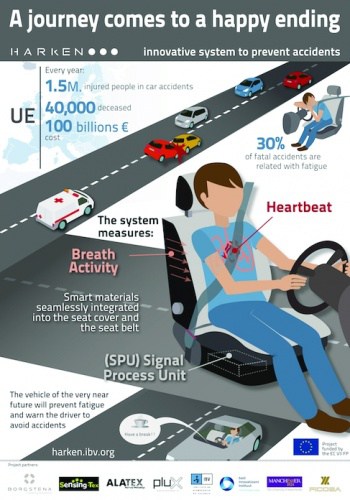This is the aim of the EU-funded HARKEN Project, which has also integrated sensors and a signal-processing unit into driving seat covers to measure the cardiac and respiratory rhythms that can indicate the onset of fatigue.
Researchers from project partners at the Instituto de Biomecánica de Valencia (Biomechanics Institute - IBV) told The Engineer that heart rate (HR) and heart rate variability (HRV) have been long studied in relation with driver’s fatigue and alertness, adding that HR decreases and HRV increases when the driver is fatigued or distracted.
Despite these factors being known and accepted, a non-invasive method of recording them has proven difficult until now.
Challenges
In use, the sensors and SPU would be integrated into the car and derive their power from the vehicle’s 12V battery. The greater challenge in developing a prototype device was sensing heart rate and respiration non-invasively; then distinguishing between signals given off by movements of the driver and the car itself.
‘The system uses adaptive filtering to eliminate them,’ said Dr. José Solaz, IBV Innovation manager, Automobile & Mass Transportation. ‘Some sensors are used to estimate a reference signal of those artifacts, and this signal is used to “clean” the raw signals measured by the sensors.’
Vibrations from the vehicle’s engine are not problematic because it has a spectrum with higher frequencies than physiological signals of the driver, so the greatest part can be filtered by standard techniques.
Similarly, everyday driving actions such as performing and emergency stop will not adversely affect the system, claim the IBV team.
‘[The] safety belt works, in this case, as a sensor, but it keeps its normal functions as a passive safety element,’ said Dr. Solaz. ‘Sensing technology integrated in the seatbelt does not respond to this kind of strain, it is designed to measure heartbeat. The added strain on the seatbelt will add noise to the signal, which would be treated as… before.’
The Harken project does not propose solutions that will alert the driver to fatigue but IBV said they are engaged in separate projects to address this, with proposed solutions based on visual and audible warnings that change intensity depending on the sleep phase of the driver.
Prototype
Harken has now developed a fully functional prototype that has been tested by users in closed track tests in order to prove its effectiveness under real-life conditions.

In 2008 there were 1.2 million road accidents in the EU, which resulted in 1.5 million casualties and 38,000 fatalities. This kind of accident will be the third most common cause of death and disability worldwide, by 2020. According to the figures of the eSafety Forum, the proportion of fatigue-related crashes is about 8.3 per cent of all vehicle crashes.
The HARKEN project received funding from the EU FP7 Capacities Work Programme: Research for the Benefit of SMEs and started in July 2012. Academic partners include Estonia’s Eesti Innovatsiooni Instituut, Manchester University, plus industrial partners including Fico Mirrors, Borgstena Group, and ALATEX.
A similar project is taking place at Nottingham Trent University, where car seats are being developed to warn drivers of fatigue.
Being carried out in conjunction with Plessey, the feasibility study will investigate how to integrate an Electrocardiogram (ECG) sensor system directly into the fabric of car seats.
The project is being funded by the Technology Strategy Board.





Nanogenerator consumes CO2 to generate electricity
Whoopee, they've solved how to keep a light on but not a lot else.